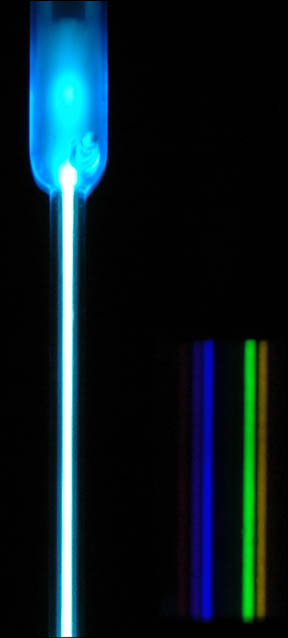Objective
Observe and measure the spectrum of colors found in white light and in single element tubes and analyze the relationship between wavelength and light diffraction through a grating.
Equipment
1) 2 Meter Sticks
2) White Light Source
3) Diffraction Grating
4) Discharge Tube and Power Supply
5) Hydrogen and Miscellaneous Tubes
Procedure
1) Set up the 2 meter sticks perpendicular to eachother on a table. Place a source of white light at the junction of the meter sticks. Place the diffraction grating at the other edge of the meter stick. Measure the distance between the light source and the diffraction grating. Look through the diffraction grating and record the apparent locations of each color on the other meter stick. Use these measurements and the diffraction grating equation to determine the wavelengths of the boundaries of each color.
2) Using the same set-up place the hydrogen discharge tube at the junction of the 2 meter sticks. Look through the diffraction grating and record the apparent positions of the bands of light created by the hydrogen light. Use the diffraction equation to determine the wavelengths of these bands.
3) Repeat the process in step 2 using an unknown discharge tube. After determining the wavelengths of the spectral bands try to figure out what the unknown element is using a database for elemental spectral lines.
Data and Calculations
White Light
using the measurements obtained in the photo above and the formula below we calculated the approximate border wavelengths for each color band.
D corresponds to the measured distance between the observed color band and the white light source.
lamda 1 corresponds to the far end of the blue color band and each subsequent wavelength corresponds to the next border of two color bands.
Hydrogen Gas
Above are the calculations for the spectral lines of hydrogen. The original wavelengths appear to be more correct than the adjusted wavelengths. This suggests that our calibration equation is inaccurate. Only 3 of the 4 visible wavelengths were observed due to the dimness of the hydrogen discharge tube.
Unknown Gas
Above are the calculations for the unknown discharge tubes. Again the original wavelengths seem more accurate than the adjusted wavelengths. We looked up a spectral line database for single elements and correctly guessed that our mystery element was Mercury.









No comments:
Post a Comment